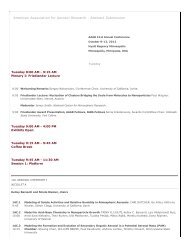Download PDF of Conference Program Book - AAARabstracts
Download PDF of Conference Program Book - AAARabstracts
Download PDF of Conference Program Book - AAARabstracts
- No tags were found...
You also want an ePaper? Increase the reach of your titles
YUMPU automatically turns print PDFs into web optimized ePapers that Google loves.
thursday, October 6<br />
8:00 am – 9:15 am<br />
heAlTh dISpArITIeS And AMBIenT<br />
AIr pArTICle polluTIon<br />
Wayne E. Cascio, East Carolina Heart Institute,<br />
Greenville, NC<br />
Abstract: Despite improvement over the last decade<br />
significant disparities in health outcomes exist within the<br />
U.S. among racial and ethnic minorities and among other<br />
groups at high risk for adverse health events such as<br />
low-income groups, women, children, aged-adults, and<br />
the disabled. Disparities in outcomes are attributed to<br />
differences in: access to and quality <strong>of</strong> health care, health<br />
insurance status, health literacy, level <strong>of</strong> educational<br />
attainment, and lack <strong>of</strong> pr<strong>of</strong>iciency with the English<br />
language. Certain individuals distinguished by intrinsic<br />
or extrinsic factors are more sensitive to or vulnerable to<br />
the effects <strong>of</strong> environmental exposures, and in particular<br />
air particle pollution. Together these individuals represent<br />
susceptible populations. For air particle pollution these<br />
characteristics include genetic background, pre-existing<br />
diseases such as respiratory and cardiovascular disease,<br />
and life stage. Modification <strong>of</strong> risk by hypertension,<br />
gender, race or ethnic background is less certain.<br />
Interestingly, a high degree <strong>of</strong> concordance exists<br />
between factors that confer increased susceptibility to the<br />
adverse effects <strong>of</strong> air pollution and the factors associated<br />
with disparities in health outcomes.<br />
For example hospitalization rates for asthma, a common<br />
respiratory condition with a strong environmental<br />
association, is four-fold higher in Black children than<br />
White children, and three-fold higher than Hispanic<br />
children. Socioeconomic conditions play an important<br />
role, as hospitalizations are two-fold greater in poor<br />
families when compared to high income families.<br />
Disparities in the rates <strong>of</strong> asthma hospitalizations can<br />
also be linked to geographical region, age and gender.<br />
Whether the increased risk <strong>of</strong> particulate matter-related<br />
health effects at the individual or population level is<br />
associated with specific social, economic, behavioral,<br />
and health characteristics deserves greater attention<br />
because the answer to this question will weigh heavily in<br />
developing mitigation strategies.<br />
www.AAAR.org<br />
plenary lectures<br />
43



